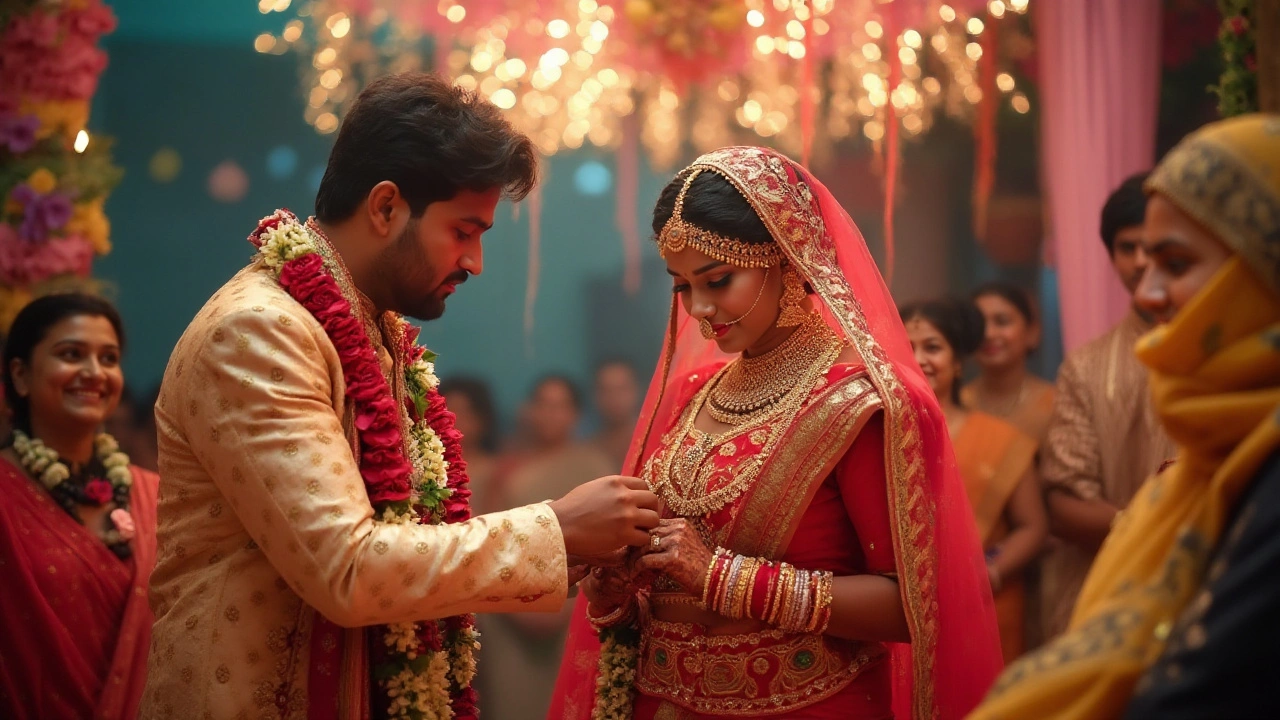
The wedding garter tradition may seem like a whimsical flourish in today's weddings, but it carries a fascinating history that spans centuries. Its origins take us back to times when luck and superstition ruled celebrations, and the bride's garments were considered tokens of good fortune. Understanding this light-hearted tradition offers a glimpse into the cultural journey of wedding customs, blending the old with the new.
While the practice has evolved, its core purpose speaks to themes of love, luck, and the joining of two lives. For grooms, the task of removing the garter is not only a moment of fun but also an opportunity to honor these deeper meanings. In exploring cultural variations and modern adaptations, this article provides insight into how this time-honored tradition can be embraced in a way that suits today’s couples best.
- Historical Origins
- Cultural Variations
- Modern Interpretations
- Symbolism and Meaning
- Fashion and Style
- Tips for Grooms
Historical Origins
The tradition of the garter tradition is deeply woven into the tapestry of wedding customs, with roots tracing back to the medieval era. During this time, weddings were viewed through a lens of superstition and prosperity. It was commonly believed that possessing a piece of the bride’s attire would grant guests good luck. This belief often led to rather chaotic post-ceremony traditions wherein eager participants would aggressively seek to obtain parts of her wedding dress. To put an end to this disorderly practice, it became customary for the groom to remove and toss the garter instead, as a symbol of good fortune, thus preserving the bride’s modesty while still fulfilling the guests' desire to share in the couple’s luck.
As with many customs of the past, the garter's significance has metamorphosed over time. Initially, the garter was not a fashion accessory but a necessity, crucial for holding up stockings. This functional piece of clothing became a symbol during weddings, intertwining practicality with cultural beliefs. By the 18th and 19th centuries, the tradition had shifted to a more playful act, highlighting the groom’s role while maintaining the festive spirit of weddings. Its progression over time clearly reflects societal changes, where the meanings attributed to wedding practices often intertwine rituals of intimacy with public celebration. This fascinating journey from utility to symbolism captures how deeply cultural perceptions can transform.
Interestingly, the custom also finds mentions in varying forms across different cultures. For example, in France, a variation involved the guests chasing the bride to gain possession of the garter, which was a similar nod to luck-driven pursuits. These traditions not only reveal an intricate web of symbolism and superstition but also showcase the role of community in celebrations. As one historian aptly remarks, "Traditions are the vivid expressions of a society’s deepest beliefs and desires," a notion that rings true as we trace the origins of why husbands remove the garter during wedding ceremonies.
Cultural Variations
The practice of removing the bridal garter is a fascinating custom that wears different shades across cultures, each with its own unique story. In English weddings of centuries past, the tradition was part of an old ritual where guests would chase the bride to fetch a piece of her attire, believed to bring good luck. This often led to a frenzied affair, which eventually evolved into the more subdued garter removal conducted by the groom today. In contrast, French weddings often involve the groom removing the bridal garter earlier in the festivities, with the piece being auctioned off to the highest bidder among the wedding guests. This not only brings an element of fun but serves as a way to ensure a little extra blessing for the married couple.
Spanish weddings offer another intriguing twist, where the garter and the groom’s tie are removed simultaneously as part of a dance. These items are then cut into pieces and shared among friends and family, symbolizing unity and a prosperous future. In certain regions of Italy, the practice takes on a competitive edge, featuring men racing to be the first to retrieve the garter. The victor is said to be blessed with good luck and the next in line for marriage. Each of these cultural expressions emphasizes the role of customs in weaving personal meaning into matrimonial rituals.
Across the Atlantic, American weddings carry on the tradition with varying degrees of playfulness. Traditionally, the groom removes the garter and tosses it to the unmarried male guests of the reception, much like the bride’s bouquet toss. The garter toss is often accompanied by laughter and cheers, as it is believed the recipient will be the next to wed. This reflects the more lighthearted and celebratory aspect that modern Western weddings have embraced.
Even within the same cultural context, individual preferences can shape how the ritual is performed. Some contemporary couples opt for a more private moment, while others may choose to forego it altogether in favor of new traditions. This is a reflection of how wedding customs continue to evolve, adapting to the personal tastes and values of those participating in them. According to wedding historian Susan Waggoner, "The great thing about traditions is that they are flexible. Today they allow families to celebrate their way, in a manner that holds the most meaning to them."
Susan Waggoner's exploration of wedding rituals shows how these age-old traditions blend seamlessly with today's personal touches.
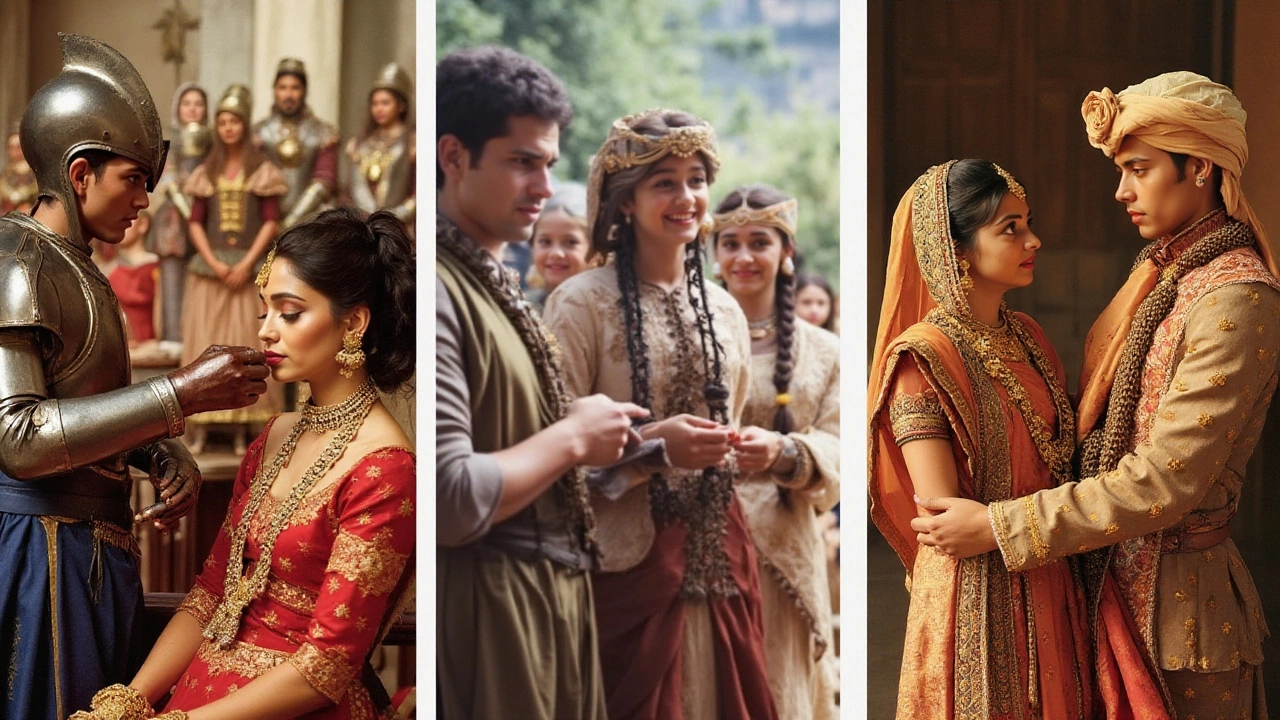
Modern Interpretations
In recent years, the garter tradition at weddings has seen a transformation. Its origins may be steeped in rites that speak of luck and protection, but today's couples approach it with flexibility and creativity, tailoring the ritual to fit their personal style and comfort. The task of removing the bridal garter has shifted from a rigid ceremony to an element of entertainment. Modern weddings embrace this tradition, allowing it to complement the unique atmosphere and personality of the couple's special day. This ceremony can be choreographed to pop music, transforming the simple act into a dynamic performance with the groom playfully fetching the garter from the bride's leg. Such alterations reimagine the age-old practice, catering not only to the couple’s individuality but also to the enjoyment of their gathered guests.
As with many evolving wedding traditions, today's couples are finding ways to make the garter removal not just about provocation but about celebration—honoring its roots while making it relevant for their gathering. The garter can be subtly designed to match the bride's gown or symbolize something meaningful to the couple, adding layers of personalization to this beloved ritual. What's more interesting is the shift towards inclusivity within this tradition. LGBTQ+ weddings are incorporating this custom in innovative ways, rooting for love and equality, while multifaceted traditional roles in modern weddings are breaking away from set gender expectations, blending the garter removal into a shared moment of joy.
"Modern weddings are about embracing traditions that resonate with us personally," says renowned wedding planner, Grace LeClerc. "It's about taking what was and making it uniquely yours, reflective of the couple's shared journey."
The contemporary garter ritual also reflects societal changes, acknowledging the importance of consent and mutual respect between partners. The playful act now comes with the understanding that comfort and mutual agreement define how the ritual unfolds. This adds a new dimension to the tradition, ensuring it is a joyful and consensual experience for both the bride and groom. Some couples opt for a more subtle approach, incorporating the garter as part of a fun photo op or using it as a prop in a surprise dance routine. These creative interpretations allow the couple to engage with their guests in a light-hearted and memorable way, making it a cherished moment that resonates long after the celebration has ended.
Modern couples are continuously redefining wedding norms, and the garter ritual is no exception. There's a growing trend where couples opt for charity garters, turning this tradition into an opportunity to give back. These garters often come with a message or cause close to the couple’s hearts, parting the intimate gesture with a layer of altruism. By purchasing these, not only do they signify marital luck, but they also contribute to causes, making it a doubly meaningful exchange. As weddings increasingly reflect personal values, the garter becomes a symbol of both romance and social consciousness, merging personal celebration with broader compassionate impact.
Symbolism and Meaning
While the tradition of removing the bridal garter may appear to be just a playful wedding activity today, its symbolism and meaning are deeply rooted in rituals that date back to medieval times. This act, which involves the groom reaching under the bride's dress to remove the garter, was believed to symbolize the consummation of marriage. The garter itself was considered a representation of the bride's purity and the couple's fresh beginning in their new life together. In olden days, guests would follow the couple to the bridal chamber to witness the bedding ceremony, where the removal of the garter was a proof of consummation, a curious blend of anxiety and excitement for those involved.
The garter has also been seen as a token of good luck. In medieval France, there was a tradition where guests would follow the bride to her chamber and try to take her garter as a token of luck. To avoid such a chaotic scene, the groom would remove and toss the garter himself, evolving into a tradition of fun and jest. Often, the one who caught the garter was believed to be the next to marry, injecting an element of competition and thrill among the unmarried guests. Over time, this has become a light-hearted moment that adds a little spark to the wedding festivities.
In modern weddings, the garter tradition has been reinterpreted with new meanings. It is often viewed as a playful symbol of the groom's affection and a reminder of the fun side of marriage. Some couples choose to share this moment privately, reflecting a personal and intimate acknowledgment of their unity and commitment. While some weddings maintain a traditional view, others adapt the garter removal to fit the contemporary sensibilities of modesty and humor. This allows couples the flexibility to tailor the ceremony to their personalities and comfort levels.
“Modern weddings celebrate unique traditions, where the garter toss remains a playful testament of love and creativity,” explains cultural historian Rachel Nichols.
The social significance of the garter extends to its aesthetic value too. Often matched with the bride’s dress or wedding theme, the garter serves as a cherished keepsake that many brides choose to treasure. Some even opt for two garters—one to keep and one to throw—keeping with the sentimentality of the occasion. There are brides who incorporate heirloom garters, handed down through generations, as a way of honoring lineage and familial bonds. Whether for tradition or personal preference, the act of garter removal continues to be a performative aspect of the wedding, imbibed with personal and historical significance.
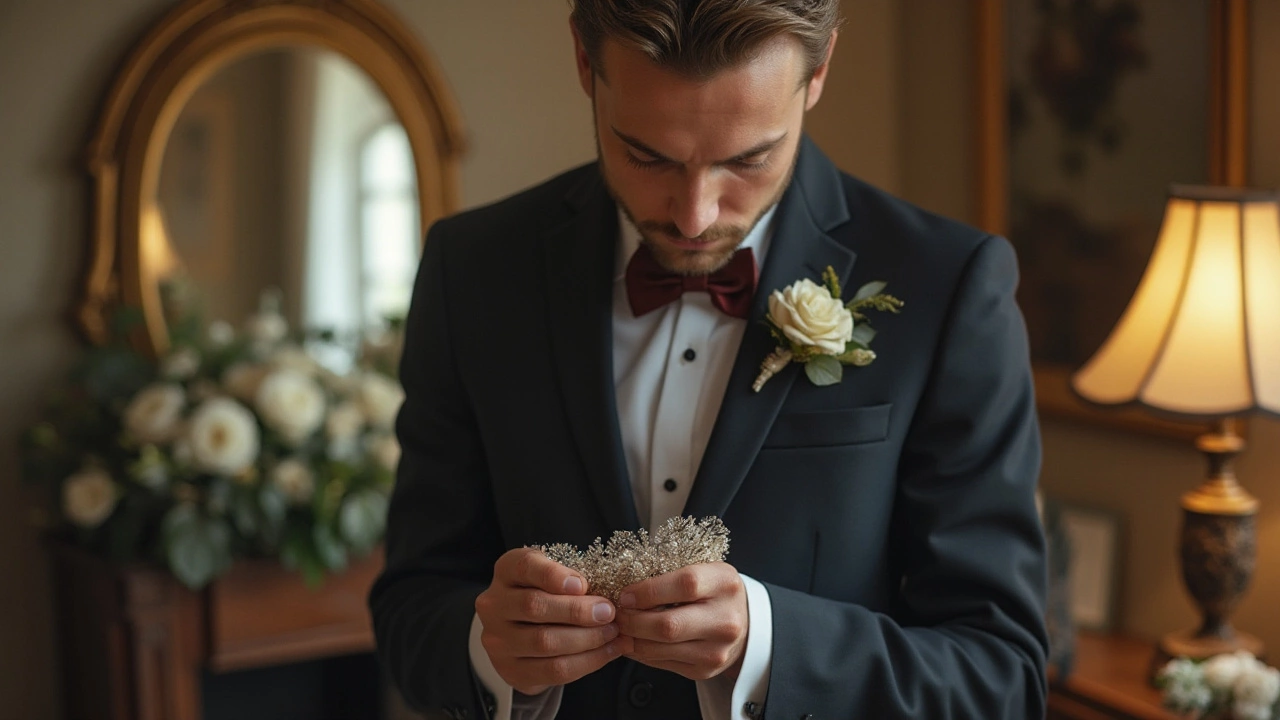
Fashion and Style
The wedding garter, an age-old tradition, has evolved significantly in terms of fashion and style. Originally, garters were practical items worn to hold up stockings in the days when elastic hosiery didn't exist. Today, they serve as a piece of ornamental lingerie, often personalized to reflect the bride's taste. Choosing a garter involves considering the fabric, design, and embellishments, which can range from lace, satin, and silk to rhinestones and pearls. Each choice carries its own symbolism and can enhance the atmosphere of the wedding ceremony.
For modern brides, the garter often complements the rest of the wedding attire. While classic white or ivory are popular, many brides choose garters in their wedding theme colors or incorporate 'something blue' as a nod to tradition. Fashion designers have embraced this tradition by creating intricate designs that add a touch of elegance and whimsy. The inclusion of a garter can also strategically be an opportunity for brides to wear a family heirloom, making the ritual even more significant.
Bridal stores and designers now offer bespoke garters, which means they can be customized in many ways – from the fabric to embroidery of initials or wedding dates. Some garters are even designed with a dual-layer, allowing the bride to keep one as a memento while the other is tossed during the ceremony. This toss is a playful moment shared with guests, symbolizing luck and prosperity. Renowned fashion houses like Vera Wang and Oscar de la Renta feature garters in their collections, underlining their continued relevance in bridal fashion.
In recent years, the advent of gender inclusivity within fashion has introduced garters that break traditional norms. Grooms choosing to wear their own matching garters is gradually trending, which provides a harmonious aesthetic in wedding photos and a twist on the traditional gender roles. This shift also highlights the personal touch individuals bring to their wedding ceremonies, where self-expression merges with tradition. A quote from Vogue aptly captures this sentiment:
"The wedding garter is no longer a hidden secret; it's a sartorial statement of individuality and elegance."
Deciding how the garter fits into the wedding theme involves careful consideration and creativity. Couples are encouraged to think about what the garter represents for them and how it can be incorporated meaningfully into their wedding day. Museums and exhibitions showcasing wedding traditions often display garters as a symbol of the intimate, yet universal, language of weddings. The melding of old and new, practical and ornate, is what makes the fashion and style of the garter a lasting tradition.
Tips for Grooms
As the pivotal moment in any ceremony where tradition and modernity merge, the practice of removing the bridal garter often takes center stage. This age-old custom has transformed over time, evolving from its mysterious origins to become a playful highlight of the wedding celebration. But how can grooms ensure that this moment is memorable for the right reasons? Understanding both the sentiment and the style is key. For grooms, this involves not just executing a practiced skill, but also encapsulating grace and humor in a tradition enjoyed by all generations.
To begin, consider the timing and setting. Traditionally, the garter removal is performed at the reception, often after the first dance, when the atmosphere is jubilant, and guests are in the mood for light-hearted fun. The location should be comfortable with adequate seating for the bride, allowing her to feel relaxed. Grooms should remember, this is an intimate moment, shared in a public space, so keeping it tasteful yet amusing is important. Consider having a quiet word with your partner beforehand to ensure mutual comfort and expectations are managed.
A common question among grooms is how to approach the physical aspect of the garter removal. It may seem daunting, but approaching it with confidence and a touch of humor can ease any tension. Keep in mind that the garter is worn on the right or left leg, typically about mid-thigh. Some couples might add to the moment with a playful song choice, such as jazz or a popular anthem, setting the right tone for a memorable performance. This adds an element of surprise and allows you to express your personal style and maybe even showcase your dance moves. As one seasoned wedding planner remarked,
"When it comes to wedding moments, it's about capturing the smiles and laughter in the room; the garter removal is where tradition meets fun, so make it count!"
Attire and presentation play subtle roles in delivering the perfect garter moment. As a groom, being well-dressed exudes confidence, aligning with the ceremony's celebratory nature. Choosing a well-fitted groom suit complements the formality and showcases an appreciation for occasion, while a boutonnière could add a dash of personal flair. An unexpected tip: practice makes perfect. Whether rehearsing with your partner or seeking counsel from a trusted friend, this can be beneficial in mastering the technique and ensuring both speed and grace. Intriguingly, about 60% of grooms these days opt for a coordinated look with their groomsmen during this moment, fostering a sense of camaraderie and style continuity throughout the event.
The manner of tossing the garter invites creativity as well. Traditionally, it's tossed to a group of eager bachelors, similar to the bouquet toss. However, some grooms may choose to include all male guests, a modern twist that acknowledges diverse guest lists. While the garter's flight is meant to entertain, the myth of catching it leading to marriage can add an extra layer of jest to the proceedings. Ultimately, the most important aspect to remember is to enjoy it, letting your joy become infectious among family and friends. The garter toss embodies destiny, humor, and camaraderie, providing an opportunity to embrace whimsy in your wedding day experience.
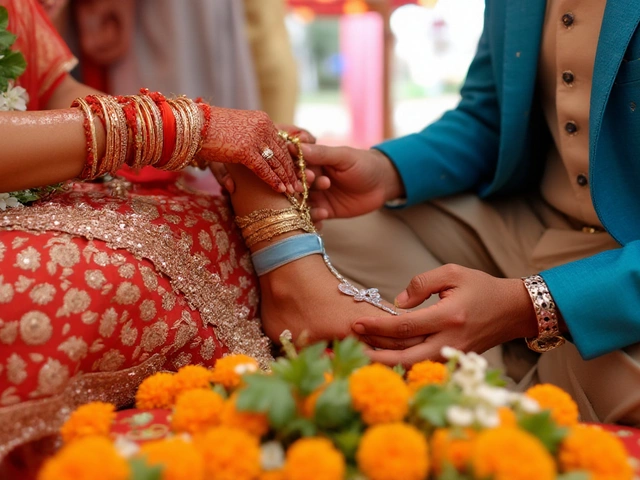
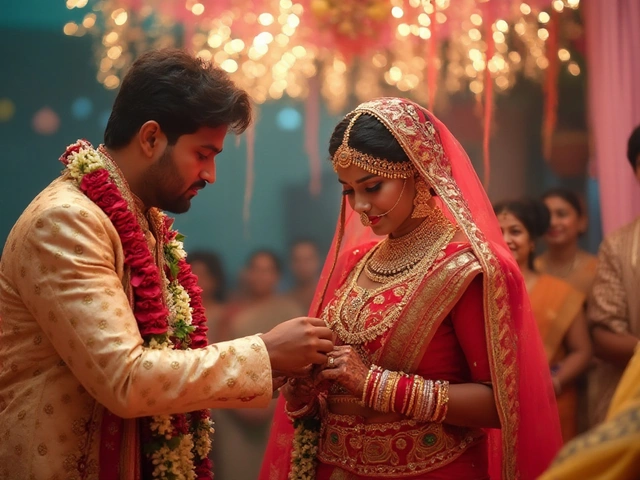

Comments
Post Comment